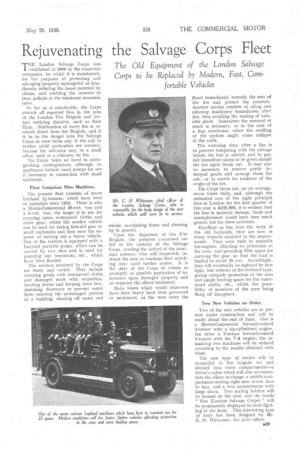Rejuvenating the Salvage Corps Fleet
Page 53

If you've noticed an error in this article please click here to report it so we can fix it.
THE London Salvage Corps was i established in 1866 by the insurance companies, by which it is maintained, for the purposes of protecting and salvaging property endangered at fires, thereby reducing the losses incurred by claims, and enabling the insurers to issue policies at the minimum economic rates.
So far as is practicable, the Corps attends all reported fires in the area of the London Fire Brigade and certain outlying districts, such as East Ham. Notification of every fire is received direct from the Brigade, and if it be in the danger area the Salvage Corps at once turns out; if the call be farther afield particulars are awaited, because the outbreak may be a small affair, such as a chimney on fire, The Corps takes no hand in extinguishing conflagrations, although its appliances include hand pumps for use if necessary in connection with small outbreaks.
Fleet Comprises Nine Machines.
The present fleet consists of seven Leyland 3i-tonners, which have been in operation since 1923. There is also a Morris-Commercial 30-cwt. van and a 5-cwt. van; the larger is in use far carrying extra waterproof cloths and other gear, whilst the smaller vehicle can be used for taking first-aid gear to small outbreaks and thus save the expense of turning out a heavy vehicle. One of the tenders is equipped with a Leyland portable pump, which can be carried by two men and is used for pumping out basements, etc., which have been flooded, The services rendered by the Corps are many and varied. They include covering goods with waterproof cloths and damaged roofs with tarpaulins, locating drains and keeping them free, damming doorways to prevent water from entering the undamaged portion of a building, clearing off water and smoke, sawdusting floors and cleaning up in general.
Upon the departure of the Fire Brigade, the premises concerned are left in the custody of the Salvage Corps, pending the arrival of the insurance assessor, who will frequently instruct the men to continue their watching duty until further orders. It is the duty of the Corps to obtain as promptly as possible particulars of insurances upon damaged property and to acquaint the offices interested.
Many losses which would otherwise have been heavy have been prevented . or minimized, as the men enter the _ floors immediately beneath the seat of the fire and protect the contents. Another service consists of oiling and cleaning machinery immediately after fire, thus avoiding the rusting of valuable plant. Sometimes the removal of stock is necessary, as in the case of a hop warehouse, where the swelling of the pockets might cause collapse of the walls.
The watching duty after a fire is to prevent tampering with the salvage• before the loss is settled, and to permit immediate alarm to be given should the fire again break out. It may also be necessary to remove partly destroyed goods and arrange them for sale, or to search for evidence of the origin of the fire.
The Corps turns out,on an average, seven t;mes daily, and, although the estimated cost of the eight principal fires in London for the first quarter of this year is £325,000, it is evident that the loss in material damage, trade and unemployment would have been much greater but for these activities.
Excellent as has been the work of the old Leylands, they are now in many tespects unsuited to the requirements. They were built to resemble fire-engines, affording no protection to the crew, and providing little space for carrying the gear, so that the load is limited to about 30 cwt. Accordingly, they will eventually be replaced by four light, fast vehicles of the enclosed type, giving adequate protection to the men and ample loading space for the waterproof cloths, etc., whilst the possibility of members of the crew being flung off disappears.
Two New Vehicles on Order.
Two of the new .vehicles are at present under construction and will he ready about the end of June. One is a Morris-Commercial forward-control 2-tonner with a six-cylindered engine, the other a Fordson forward-control 2-tonner with the V-8 .engine: the remaining two machines will be ordered according to the results obtained With these.
The new type of tender will be enamelled in fire brigade red and divided into three compartments—a driver's cabin which will also accommodate the officer-in-charge, a middle compartment seating eight men across, face to face, and a rear compartment with large doors. Two scaling ladders will be housed on the roof, and the words "Fire (London Salvage Corps) " will be prominently displayed in neon lighting at the front. This interesting type of body has been designed by Mr. G. H. Whiteman, the chief officer.




























































































